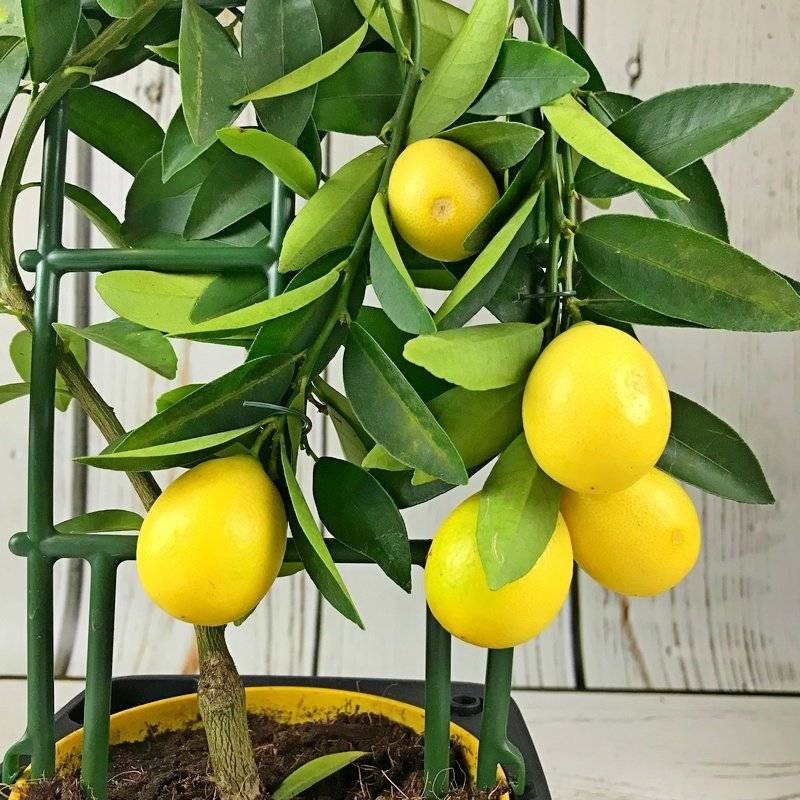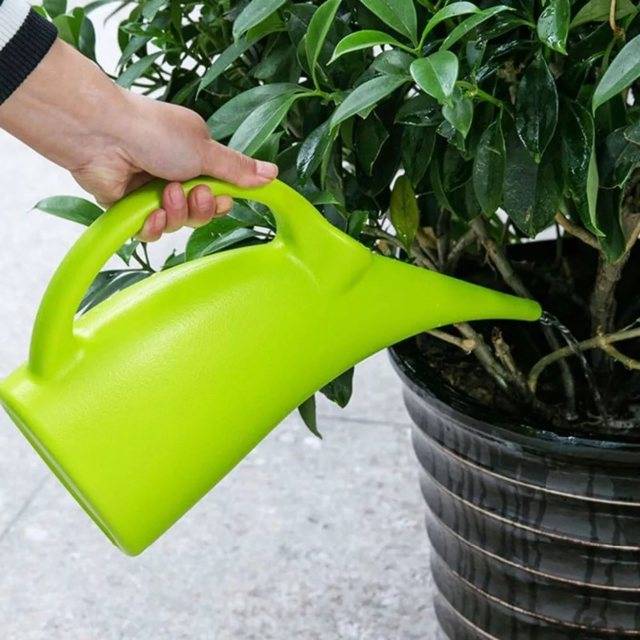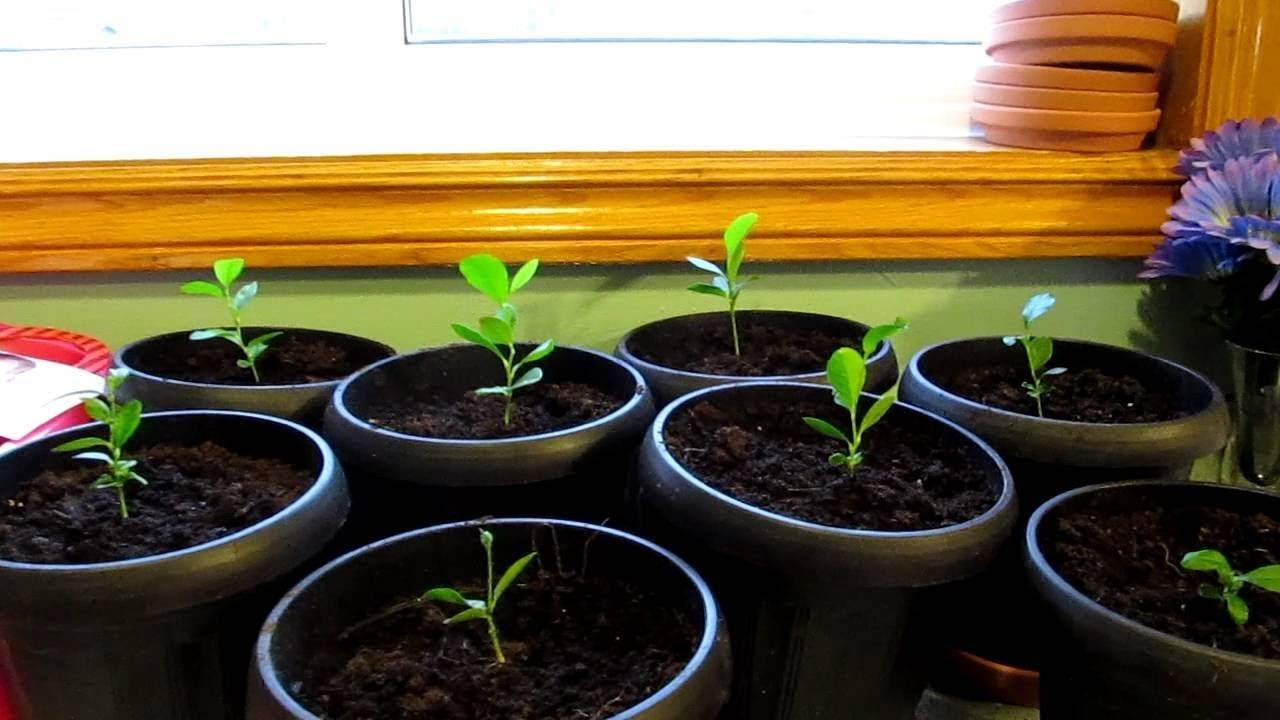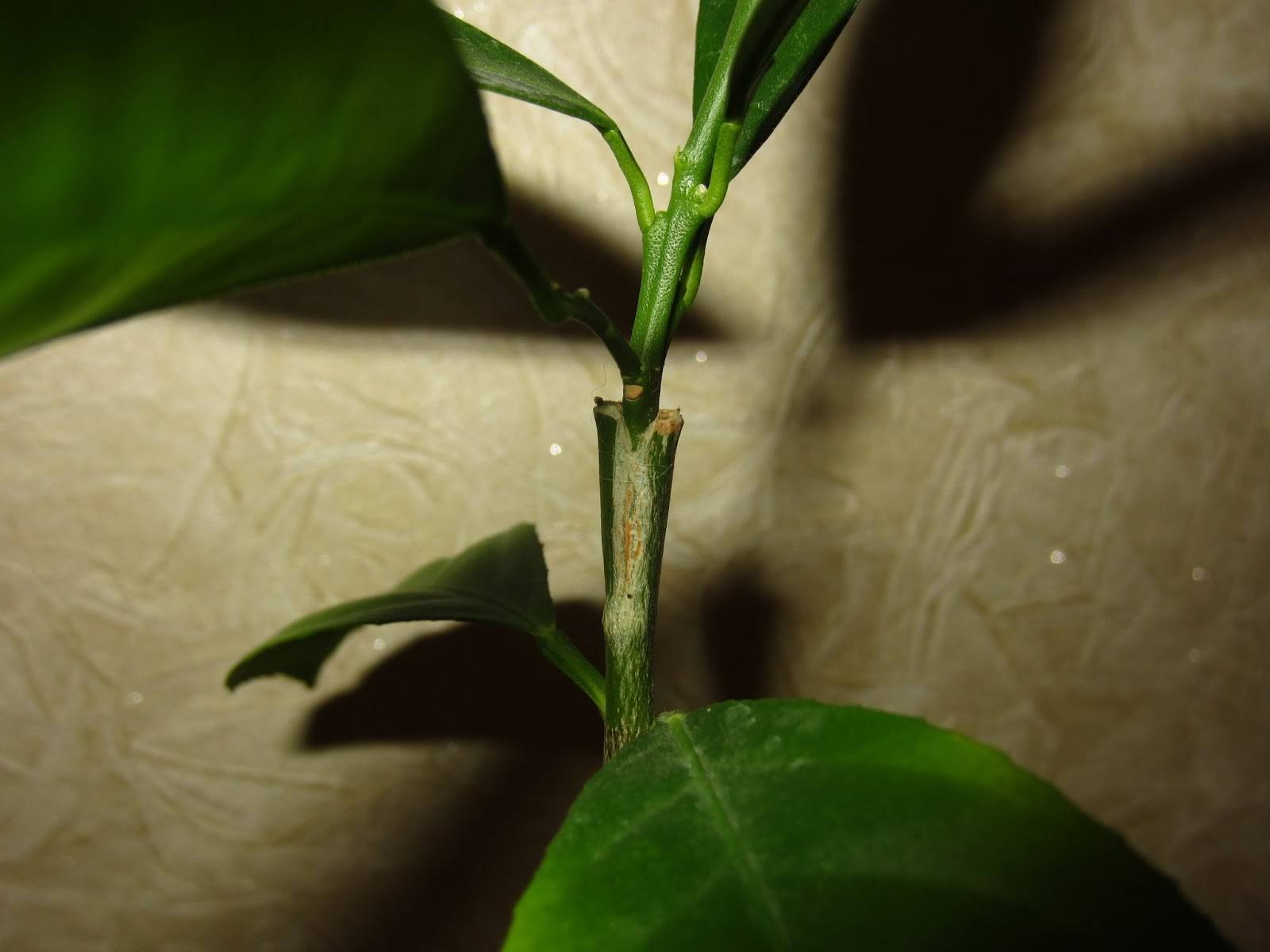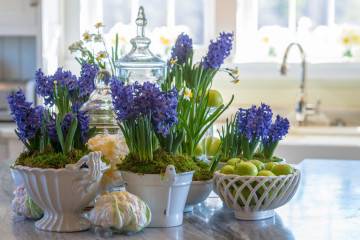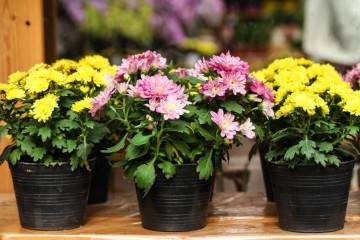How to care for a lemon growing at home in a pot
Content:
Many flower lovers have a lemon tree on the windowsill. But not all growers know how to care for a lemon at home in a pot. With a little effort, the evergreen shrub will delight you with an attractive appearance and rich harvest.
Description of the culture and the best varieties
A lemon bush grown on a windowsill can grow up to 2 meters. The lush tree has many dark green leaves that do not change color. Lemon leaves will decorate the windowsill, and snow-white flowers will fill the room with aroma. Lemon blooms with snow-white flowers, collected in tassels of 3-5 pieces.
The native land of wild-growing lemon is India. Later he was brought to America and Africa. Lemon became widespread in Europe at the beginning of the 18th century. Nowadays, lemon is popular, the tree of which can live up to 100 years. It is also grown in Russia.
The types of citrus crops can be divided into 2 groups:
- tree-like;
- bushy.
Treelike species up to 6 meters high have a dense crown. Bushy grows to a height of about 4 meters. In Russia, only low-growing tree varieties are grown due to climatic conditions. The most famous varieties of lemon that are widely used are:
- Novogruzinsky;
- Rough-skinned;
- Eureka;
- New Zealand;
- Irkutsk.
Indoor lemon varieties
Breeders have developed many varieties that can be grown in the room. There are more than 150 of them. The most popular and unpretentious are:
- Pavlovsky. Shade-tolerant variety, reaching a height of up to 2 meters. Budding and the appearance of fruits begins in the third year of life. The fruit has a thin skin and a sweet and sour taste. Up to 15 juicy fruits are formed on the tree.
- Meyer. Cold-resistant plant up to 1.5 meters high. Flowering begins in spring. Fruiting lasts all year round. The fruit has orange flesh, which is slightly acidic, thin skin. Its weight reaches up to 80 grams.
- Panderoza. An unpretentious hybrid with a height of more than 1 meter. Differs in the presence of thorns in an adult plant. Flowering occurs 2-3 times a year. Its fruits, weighing up to 100 grams, have a dense rind.
- Lunario. The variety is grown on trellises, as it has long, spreading branches. Reaches 1-2 meters in height. Flowering lasts all year round, after which the fruits appear. They have an oblong shape with a sharp tip.
- Lisbon. The drought-resistant variety has an abundant leafy crown. In winter, it needs additional lighting. It reaches a height of about 2 meters. A distinctive feature is abundant fruiting. It bears more than 50 fruits per year.
- Volcano. Dwarf variety up to 1 meter high. There are thorns on the trunk. A distinctive feature is the fruit reaching 4 cm in length.
Lemon tree care rules
To grow lemon at home, you need to take it seriously. Although a subtropical plant is considered unpretentious, it needs certain conditions and timely care.
The first point is choosing a healthy seedling. To get it, you can independently apply such propagation methods as cuttings, grafting, planting bones. When buying a seedling, it is necessary to inspect it. The leaves of the plant should be shiny with a bright color. After the plant has entered the house, it needs to adapt for 1.5-2 weeks. Only after this period can citrus be transplanted.
To achieve a harvest at home, you need to learn the basic rules for caring for lemon:
- the right choice of growing place;
- timely watering;
- optimal temperature;
- lighting;
- regular spraying;
- top dressing;
- transfer;
- suitable soil;
- crown formation.
Lighting and temperature requirements
Lemon likes well-lit places. Therefore, a window sill with a lot of light is perfect for a home tree. But you should avoid direct sunlight. With prolonged exposure to sunlight, burns form on the leaves of the plant. To solve the problem, you can shade the window with a newspaper.
The main point in growing citrus plants is the temperature regime. The optimum temperature is + 14-20 degrees. It is impossible to allow sharp jumps in temperature below 14 degrees. Otherwise, it will lead to shedding of foliage, the plant may even die.
Humidity level
Citrus does not like dry air, especially a young seedling. He needs abundant watering and daily spraying. In the summer months, it is necessary to water the plant as the upper soil layer dries up, but not more than 3 times a week. It is impossible to allow stagnation of water in the pot so that the roots do not rot. For better moisture absorption, the soil should be loosened. Prefers pure citrus water, separated, at room temperature.
To grow a healthy tree, it is necessary to organize high humidity for it. The optimum is 50-70%. In the summer, the plant must be irrigated daily with settled water from a spray bottle. You can also put a container of water next to it. It is recommended to give the plant a shower every week.
Features of care during the rest period
Plant care in winter and summer is significantly different. Winter is a dormant period for many plants. To preserve the citrus tree in winter, it needs to create optimal conditions:
- 14-hour daylight hours with additional lighting. With a lack of light, the stems of the plant stretch out.
- Provide a constant temperature of + 14-17 degrees. Do not allow the thermometer to drop below 14 degrees. It is fraught with disease.
- Reduce the number of waterings to 1 time per week. Frequent watering leads to the death of the citrus or damage to it by pests.
- It is not recommended to place a pot of wood close to radiators.
- You can not transplant and propagate the lemon tree during the dormant period.
In summer, the pot with a seedling must be ventilated, while drafts and winds should be avoided. With the onset of spring, the plant must be fed with nitrogen fertilizers. The next top dressing is applied when budding begins. During the rest period, the lemon does not need fertilizers.
Pollination of lemon
There are bisexual flowers on a citrus tree. But sometimes, in order to increase the yield and achieve fruiting, it is necessary to carry out a pollination procedure. It is done manually. For this, pollen is collected from some flowers with a brush and transferred to others.
Diseases and pests
Like many indoor plants, under unfavorable conditions, the lemon can be exposed to various diseases and pest attacks. It is most often affected by viral, infectious and fungal diseases. The most common diseases are:
- Gomoz. Brown spots on the leaves are characteristic features. After they begin to turn yellow and fall off. The cause of the disease can be an excess of moisture, a lack of fertilizers. It is necessary to feed the plant with fertilizers with nitrogen and treat it with a solution of copper sulfate.
- Root rot. The leaves of the tree begin to dry. It is necessary to transplant the citrus into a new pot, removing the affected parts of the roots.
- Sooty fungus. Dark spots on the leaves and stem serve as a signal. In the fight, fungicide irrigation is used.
- Scab. It is characterized by decay of foliage, stems and dropping of fruits. For prevention, you need to cut off all affected parts and treat with fungicides.
- Sheet mosaic. The bush lags behind in development, and also light and dark stripes appear on all its parts. It is necessary to feed the plant.
With insufficient care, the lemon can be attacked by insect pests:
- aphid;
- spider mite;
- melseco.
At the first signs of detection of insects, it is necessary to remove the affected parts and treat with solutions of fungicides.
Growing lemon from seed
Even without special skills, you can grow a lemon from a seed yourself. To harvest the seeds, you need to pick up a ripe fruit. To increase the likelihood of germination, the seeds do not need to be dried, but only rinsed in warm water. Then they are planted in a prepared substrate.
To increase the germination rate, experienced gardeners are advised to first free the seed from a thick and hard shell, and then soak it for a couple of hours in a growth stimulant solution.
Winter is considered a favorable time for sowing. If the seeds are planted at the end of winter, the germinated sprouts will take root better when daylight hours begin to increase. Citrus plants love warmth, in order to grow seedlings from seeds, it is necessary to provide them with an optimal temperature of + 22-25 degrees. Cover the pots with crops on top with foil, creating the effect of a greenhouse. Every day it is necessary to ventilate and irrigate the soil with a spray bottle. The appearance of the first shoots can be observed 2-3 weeks after planting. Immediately after the sprouts appear, they are fed with fertilizers.
Citrus primer
In order for the plant to develop well, it needs to choose the right soil. You can buy ready-made citrus soil or prepare it yourself by mixing in equal proportions:
- turf;
- sand;
- clay;
- rotted compost.
The soil should be light and loose, before planting it is thoroughly mixed. To ensure the supply of oxygen to the roots, drainage from expanded clay or small pebbles is laid on the bottom of the pot.
Pot selection
You can plant seeds in plastic cups, several pieces each. When 4 leaves appear on the sprouts, they dive into separate pots. Do not take oversized containers. This can cause stagnant water, leading to root rot. It is enough if the capacity is 1-2 cm larger than the root system.
It is recommended to replant young plants annually, picking up a pot with a diameter 1 cm larger than the previous one. Plants at the age of 5 years are transplanted every 5 years.
Decorative properties of lemon
Due to its lush crown, snow-white flowers and fruits, the lemon can become an ornament not only for the windowsill, but also for the terrace and balcony. To form a lush crown, the plant must be pinched in the spring.To do this, cut off the middle stalk with a sharp knife.
How to plant a lemon tree to bear fruit
A lemon grown from a seed begins to bear fruit only at 6-7 years of age. To speed up the fruiting process, you can use the grafting method. If the process is carried out correctly, the tree will begin to bear fruit in 3 years. Before you start grafting, you need to grow a seedling with a strong root system. Next, you should prepare the material. They will serve as a stalk from an adult lemon of the variety that is grown indoors.
The right time for vaccinations is late April or early May. Vaccination can be done in two ways:
- budding;
- cleft inoculation.
Using the budding method, 2 cuttings can be grafted at the same time. Sequencing:
- The necessary instruments are disinfected.
- An incision is made on the side of the main trunk at a height of 5-7 cm.
- The grafting branch is cut with a sharp knife at an angle of 45 degrees.
- A stalk is inserted into the incision. It should fit snugly against the trunk.
- The vaccination site is wrapped with adhesive tape.
The cleft grafting method is slightly different:
- A tree is cut off at a height of 5 cm.
- The grafting material is selected, it must correspond to the size of the tree.
- An oblique cut is made on the handle, an incision is made on the trunk to a depth of no more than 2 cm.
- A branch is inserted into the incision, wrapped with tape and processed with garden varnish
All leaves must be removed from the grafted bush and covered with a plastic bag or glass jar on top.
Reproduction of lemon from the seed is the best option to achieve fast fruiting. If you graft the planting material with high quality, the tree will delight you with ripe fruits for 3 years of life.

